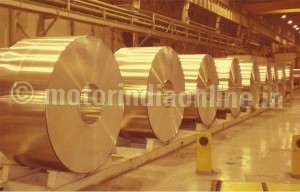Still miles to go to catch up with China
Hit hard by the slowdown in the domestic economy and resultant subdued demand from end-user sectors, India’s steel production growth eased to just 2.8 per cent in January-October in 2003, but the country faces no immediate threat of being dislodged from its position as the fourth largest steel producer globally.
growth eased to just 2.8 per cent in January-October in 2003, but the country faces no immediate threat of being dislodged from its position as the fourth largest steel producer globally.
World Steel Association’s (WSA) recently-published data showed India produced 66.387 million tonnes steel during the first ten months of the current year compared to 64.556 mt in the same period last year. The rate of production growth in October even slipped further to a mere 1.6 per cent to 5.76 mt against 6.65 mt during the corresponding month of 2012.
The growth in production recorded during the January-October period of 2012 at 64.556 mt was 5.6 per cent higher than 61.077 mt output recorded during the corresponding period of 2011. Thus, this is going to be one of the worst years for the domestic steel industry, and it is unlikely to turn for the better in an year’s time from now, say industry watchers.
Industry officials attribute the January-October subdued steel production growth to slow expansion of the economy, which has been hit by several negativities like higher inflation, current account deficit, interest rates and many others. Government’s policy paralysis is also one among the reasons.
And, the economic growth of a country has its direct bearing on steel production. The usage of steel often mirrors the health of an economy in general and the automotive sector and road infrastructure development in particular, and usually rises by 1.5-1.6 times of the country’s GDP growth rate.
India’s economic growth rate slipped to a decade’s low of five per cent in 2012-13, and during the first quarter of the current fiscal, it stood at 4.4 per cent. The feeble economic growth appears to have impacted steel-consuming segments like real estate and consumer durables, which are the major consumers of the alloy. The fate of these two important sectors depends on the purchasing power of the consumers. With high inflation and higher interest rates, the consuming class is left with hardly any money to go for luxury when onions are being sold at Rs. 90-100 per kg.
Though India was supposed to have a better growth than the world average supply because of the fact that the country is still only a developing nation and it has miles to go before it can catch up with the developing nations and its important neighbour China, India’s steel output growth stood at 2.8 per cent in the first 10 months of the current year compared with 3.2 per cent average growth recorded worldwide. China’s steel industry saw its output grow by 8.3 per cent in the same period.
The world steel production stood at 1,321 mt and China’s at 884 mt during the same period. Not to say that this is primarily because of the Chinese production. China produced 652 mt steel during the January-October period compared to 602 mt during the same period a year ago, recording a whopping 8.3 per cent growth.
During October 2013 alone, China produced 65.1 mt steel, up by 9.2 per cent compared to October 2012. Elsewhere in Asia, Japan produced 9.5 mt of crude steel in October 2013, an increase of 7.7 per cent over October 2012. South Korea’s production was 5.9 mt in October 2013, up by 5.2 per cent.
In the EU, Germany produced 3.8 mt of crude steel in October, recording an increase of 1.9 per cent compared to October 2012. Italy produced 2.2 mt, down by 10.1 per cent compared to October 2012. Spain’s production was 1.4 mt, an increase of 23.9 per cent over October 2012. France’s production was 1.3 mt, down by 1.8 per cent, while Turkey’s crude steel production for October 2013 was 3.1 mt, up by 6.9 per cent.
In October 2013, Russia produced 5.7 mt steel, a decrease of 1.5 per cent compared to the same month in 2012. Ukraine’s production was 2.6 mt in October 2013, an increase of 1.2 per cent. The US produced 7.4 mt of crude steel in October 2013, up by 8.7 per cent.
However, amid the slowing steel output, data suggests that India is unlikely to be dislodged from its fourth largest global producer tag, which it has been holding for some years now. Its immediate competitor for the position, Russia, is close to 10 mt away.
No change in the top four of the global order is also likely soon. China, which is miles ahead from the second best, Japan, is expected to retain its numero uno position. Japan so far has produced 90 mt. The US is also expected to retain the third position. It has produced 73 mt steel during the January-October period of the current year.